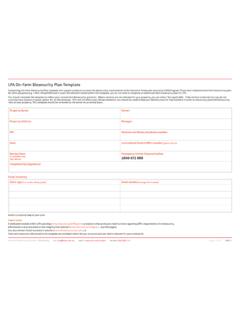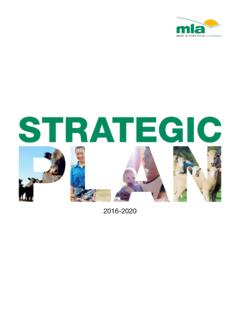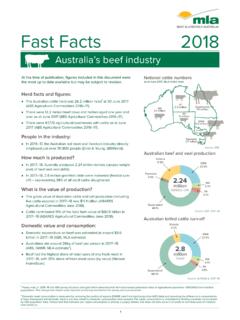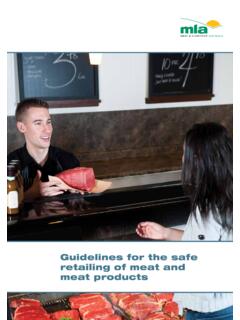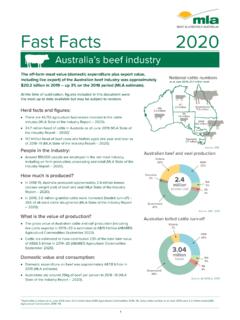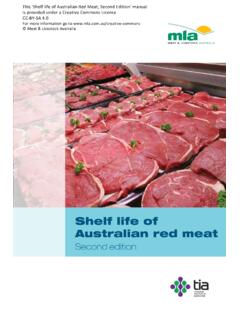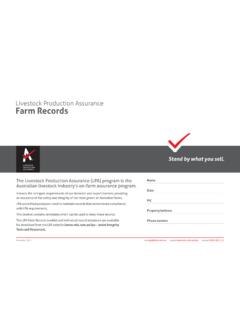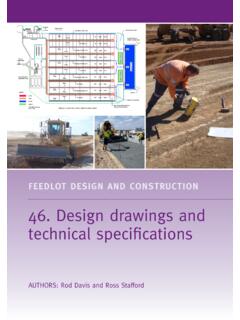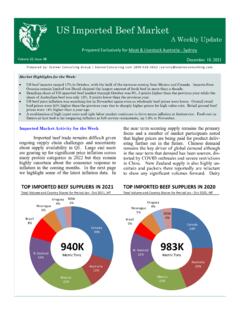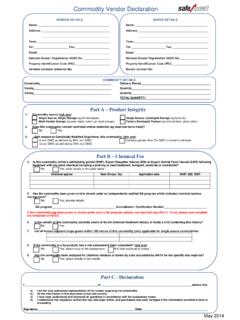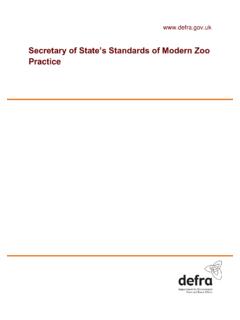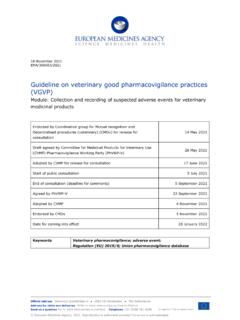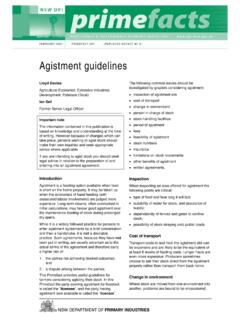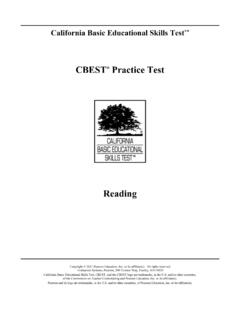Transcription of 25. Cattle crushes
1 25. Cattle crushesAUTHORS: Rod Davis and Scott Janke255. fl 25. Cattle crushesIntroductionCattle have to be constrained during routine operations, such as recording, vaccinating, ear tagging, weighing and animal health tasks (and possibly veterinary procedures). A Cattle crush holds the animal immobilised to minimise the risk of injury to both the animal and the handler. An effective livestock handling system requires a suitable choice from a wide range of commercially available Cattle operations to be performed will determine what features the crush will need, including veterinary sections, baulk gates, a squeeze mechanism or split side gates. crushes to be used in the processing facility usually have more functions than those needed for hospital facilities. Functionality and ease of use by handlers should be prime considerations. Operator safety may be improved if the squeeze section of the crush is operated hydraulically or pneumatically rather than manually. All crushes should be made according to good manufacturing standards using quality materials.
2 Cattle crushes can be equipped with ancillary equipment, such as chin bars and automated drafting systems. Electronic scales and a National Livestock Identification System (NLIS) identification reader are now standard in most feedlot Cattle crushes . Design objectivesThe Cattle crush should be designed, constructed and maintained to ensure that An animal is adequately restrained. The risk of injury to animal and handler is minimised while operations are performed. The equipment has the proven ability to effectively restrain the type of Cattle being handled. The design allows for a safe and easy release should an animal fall during the operation. Access is provided on both sides of the animal . The floor surface is non-slip. Gates and head bail operate effectively to capture and secure stock and do not release when kicked or struck. It has easy, quick and quiet operation. It has solid and secure anchorage points. It is versatile and suitable for all jobs to be performed - this will determine where access to the animal is necessary ( head, sides and rear).
3 It is safe to use for handler and Cattle with no sharp edges, protruding catches, bolts or wire. It is durable. It provides value for money. It is serviceable and easily maintained with greasing points. It is not cluttered with features irrelevant to the intended fl 25. Cattle crushesMandatory requirementsCompliance with Australian animal Standards and Guidelines for Cattle (DAFF, 2013) National Guidelines for Beef Cattle Feedlots in Australia (MLA, 2012a) National Beef Cattle Feedlot Environmental Code of Practice (MLA, 2012b) NFAS standards (AUS-MEAT, 2014). Design choicesTypically the Cattle crush is the most important part of a processing facility and everything else is planned around it. It may be part of a race, a separate facility at the end of a race, free standing under a roof or located in a suitable processes to be performed, handling requirements and personal preference will define the configuration and control of the various elements of the crush. The features to be assessed when selecting a crush include Location Functionality Design Construction Controls Electronics Operator safety Maintenance 1 provides a conceptual representation of the relationships and structure between the various elements of a crush.
4 Figure 1. Conceptual representation of crush design fl 25. Cattle crushesLocationThe following criteria need to be considered when setting up the crush Side of operation nearside or offside as most people work with Cattle from the left side, or the nearside, of the animal . Where roof is constructed over a crush, overhead lighting will need to be installed. There should be no sharply contrasting shadows or bright patches that may baulk Cattle . Cattle should be able to see well ahead. There should be no distractions to forward movement. The crush exit is designed to allow processed animals to be separated from the work area. Solid and secure anchorage points (preferably set in concrete). Access to pressurised water supply. With a roofed area, the floor surface needs to be able to be thoroughly cleaned and disinfected as are many crushes commercially available that have varying configurations. A basic crush consists of: a head restraint (head bail), side squeeze panels, associated animal control equipment ( chin bar and squeeze), veterinarian section and access gates.
5 Although some crushes have a reverse-out configuration, a walk-through design is essential when handling large numbers of Cattle . Figure 2. Features of a crushManually-operated crush. Vet sectionRear bailSqueezeHead bailFrameHydraulically-operated crush with multiple fl 25. Cattle crushesHead bailThe front end of a crush has a head bail (or neck yoke or head gate) to initially catch and restrain the animal . The head bail is operated manually using a side lever, or mechanised using a remote control. It is often adjustable to accommodate animals of different sizes. It may incorporate a chin or neck bar to hold the animal s head up and still. Regardless of the configuration, the head bail should Be safe and easy to operate with no holes in which hands or fingers could be caught. Provide adequate head control without causing injury to Cattle . Have incremental adjustment for different classes of stock. Have a positive locking system that can be operated with one hand only.
6 Be quiet when being bails may have a V-shaped or parallel opening, with or without additional head restraint ( neck extenders and/or chin lifters). The advantages and disadvantages of each type are outlined below. V-openingThe V-opening head bail consists of two bi-parting halves that have pivots at the bottom. After release, the animal walks out through the head bail. Halve bars that make contact with the animal s neck may be curved or straight. The V design has fewer moving parts and requires low maintenance. The curved bar is one of the most popular general purpose designs, with the curved bars forming a diamond shape when closed. This provides better head control because it prevents the animal from sliding its head up and down - and so reduces the need for a neck extender. The straight bar provides poorer head control because the animal can slide its head up and down. But choking is almost impossible because the straight bars cannot press on the throat. A curved bar V-opening is recommended for general Cattle handling in feedlots.
7 A straight bar V-opening is recommended where an animal must remain in the head gate for a long period. V-opening crush looking back into lead-up 3. Schematic example of straight bar V-opening crush6fiflfl fl 25. Cattle crushesParallel opening This consists of two bi-parting halves that open and close similarly to a pair of sliding doors. Halve bars may be straight or curved. The parallel opening head bail allows large animals to walk through more easily without knocking their hip bones. But the sliding mechanism is more complicated. Figure 4. Schematic example of straight bar parallel opening crushNeck extendersA neck extender is an additional neck restraint that can be attached to the head bail to reduce head movement. All neck extenders put pressure under the throat, which may hinder some tasks. Caution is required during operation, as the animal may fall in the crush. Baulk gateAt the front of the head bail, a crush may have a baulk gate that swings across to inhibit an animal s forward movement after it enters the crush and to prevent it from passing through while the head bail is being closed.
8 The key design requirements include that the baulk gate is simple and easy to latch, folds back out of the way and that rail spacings are adequate. Figure 5. Example of a baulk gateParallel-opening crush. Neck extensions on head bail chin lifter in fl 25. Cattle crushesHead restraintHead restraints are additional to neck extenders and are designed to reduce head movements for operations such as tagging ears and implanting Hormonal Growth Promotants (HGPs). Common types are chin lifters or neck bars. A chin lifter is a cup, or bar, that raises the head of the animal to a suitable, safe position. A neck bar has two parallel bars, one above and one below the head, to restrict all head movement. SqueezeMost Cattle will settle better if movement is restricted. A side squeeze immobilises the animal for safer animal control and operator safety. Squeezes range from a side gate held against the animal with a simple drop-down rod to powered, adjustable single-sided and double-sided parallel or V squeezes.
9 In a single-side squeeze, the width of the crush is altered by moving one side panel of the crush manually, hydraulically or pneumatically. This may push the animal off balance and the operator could be injured if the ratchet system intrudes into his or her and V squeezes provide greater animal holding power. The best designs are V squeeze crushes that have two movable side panels hinged at the bottom and pulled together by a lever system at the top, with both sides moving in evenly. The animal remains standing in a balanced position supported by the V shape. Correct adjustment of the space between the squeeze sides at the floor can reduce overt pressure on the lungs of Cattle being squeeze mechanism should be simple to operate. Figure 6. Schematic example of the squeeze mechanism of a crushVeterinary sectionA veterinary section is an access panel that is required for any operations at the rear end, or side, of an animal . It provides protection for operators against being kicked and should be able to be operated by either a left or right-handed person.
10 Pneumatic head restraint and pneumatic chin lifter. Yellow panels highlight nip/crush points and moving parts to handlers. Full-length squeeze where animal can stand freely without being head bailed, but this does not provide safe access to the head. 8fiflfl fl 25. Cattle crushesRear bailA rear bail can be the same style as the head bail, particularly if it is powered in the same way as a split sliding gate or solid slide in manual operations. The rear bail can be used to quickly trap an animal in the crush before it is caught with the head bail, while stopping the next animal in the race from entering the crush at the same feedlots with high throughput of Cattle use hydraulics or pneumatics, instead of manual power, to operate the Cattle crush in the main Cattle processing facility. Other facilities that handle fewer Cattle , such as hospitals, may install manual Cattle pneumatic system has better pressure control, less maintenance, and better safety and economy. The hydraulic system provides quiet, solid and more accurate correctly adjusted hydraulic or pneumatic crush is usually safer for animals and operators.
